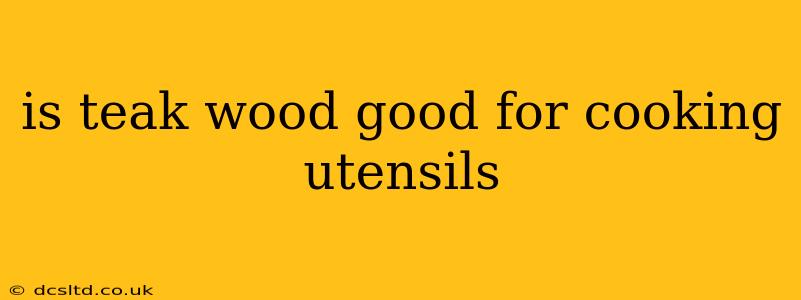Is Teak Wood Good for Cooking Utensils? A Comprehensive Guide
Teak wood, renowned for its durability and water resistance, is a popular choice for outdoor furniture and boat building. But is it suitable for cooking utensils? The answer is nuanced and depends on several factors. While teak possesses some desirable qualities, it's not the ideal material for all kitchen applications. Let's explore the pros and cons in detail.
What are the benefits of using teak wood for cooking utensils?
Teak's natural oils provide excellent water resistance, making it relatively resistant to warping, cracking, and bacterial growth compared to other woods. This resistance to moisture is a significant plus for utensils that may come into contact with water or wet ingredients. Furthermore, teak is incredibly durable, meaning it can withstand regular use and cleaning without significant wear. Its attractive grain and rich color can also add a touch of elegance to your kitchen.
What are the drawbacks of using teak wood for cooking utensils?
Despite its advantages, teak wood has limitations regarding its use in cooking. Firstly, teak is a relatively hard wood. While this contributes to its durability, it also means it can be more difficult to clean thoroughly, especially in crevices and carvings. Food particles can become lodged, potentially leading to bacterial growth if not properly cleaned. Secondly, the high oil content in teak can impart a slight taste to food, potentially impacting the flavor of delicate dishes. This is particularly true when used with hot foods or oils. Thirdly, teak wood is not heat-resistant. Prolonged exposure to high temperatures can cause it to warp, crack, or even ignite. Therefore, it’s not recommended for use near open flames or on hot surfaces like stovetops.
Is teak wood safe for cooking utensils?
Teak wood itself is not inherently unsafe, but its suitability depends entirely on the application. As long as it's used for utensils that won't come into contact with high heat or harsh chemicals, and are cleaned rigorously, the risk is minimal. However, choosing other wood types specifically designed for kitchen use, like maple or bamboo, might be a safer and more practical option.
What are some alternative wood types for cooking utensils?
Several wood types are specifically designed and better suited for cooking utensils. These include:
- Maple: Known for its hardness, durability, and resistance to warping.
- Bamboo: A sustainable and naturally antibacterial option.
- Birch: A strong and lightweight option, often used for spoons and spatulas.
- Beech: A hard wood that's resistant to moisture and relatively inexpensive.
Can teak wood cutting boards be used for cooking?
While teak cutting boards are popular, they're not ideal for all culinary tasks. Their porous nature means they can absorb juices and odors, and may not be the best choice for raw meats. Regular cleaning and oiling are essential to maintain hygiene. However, for cutting fruits and vegetables, a teak cutting board is a viable option, provided it’s properly maintained.
How do I care for teak wood cooking utensils?
If you choose to use teak cooking utensils, proper care is paramount. Hand wash them thoroughly with warm, soapy water after each use, ensuring all crevices are cleaned. Avoid using harsh chemicals or abrasive cleaners. Allow the utensils to air dry completely before storing to prevent mold and mildew growth. Regularly oiling the wood with a food-safe mineral oil can help maintain its condition and prevent cracking.
In conclusion, while teak wood's durability and water resistance are appealing, it’s not the optimal choice for all cooking utensils. The potential for taste transfer, difficulty in cleaning, and lack of heat resistance outweigh the benefits for many kitchen applications. Consider the specific use and carefully weigh the pros and cons before incorporating teak into your cookware. Choosing dedicated kitchen-safe wood types is often a more practical and hygienic approach.
